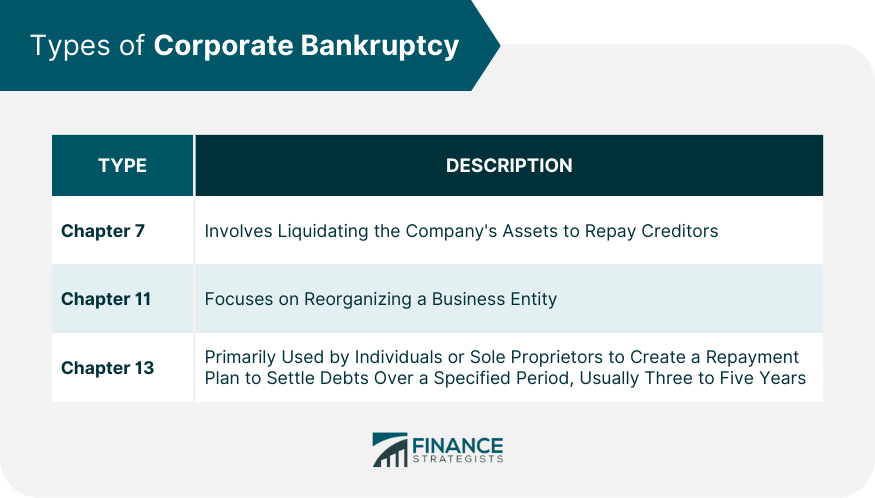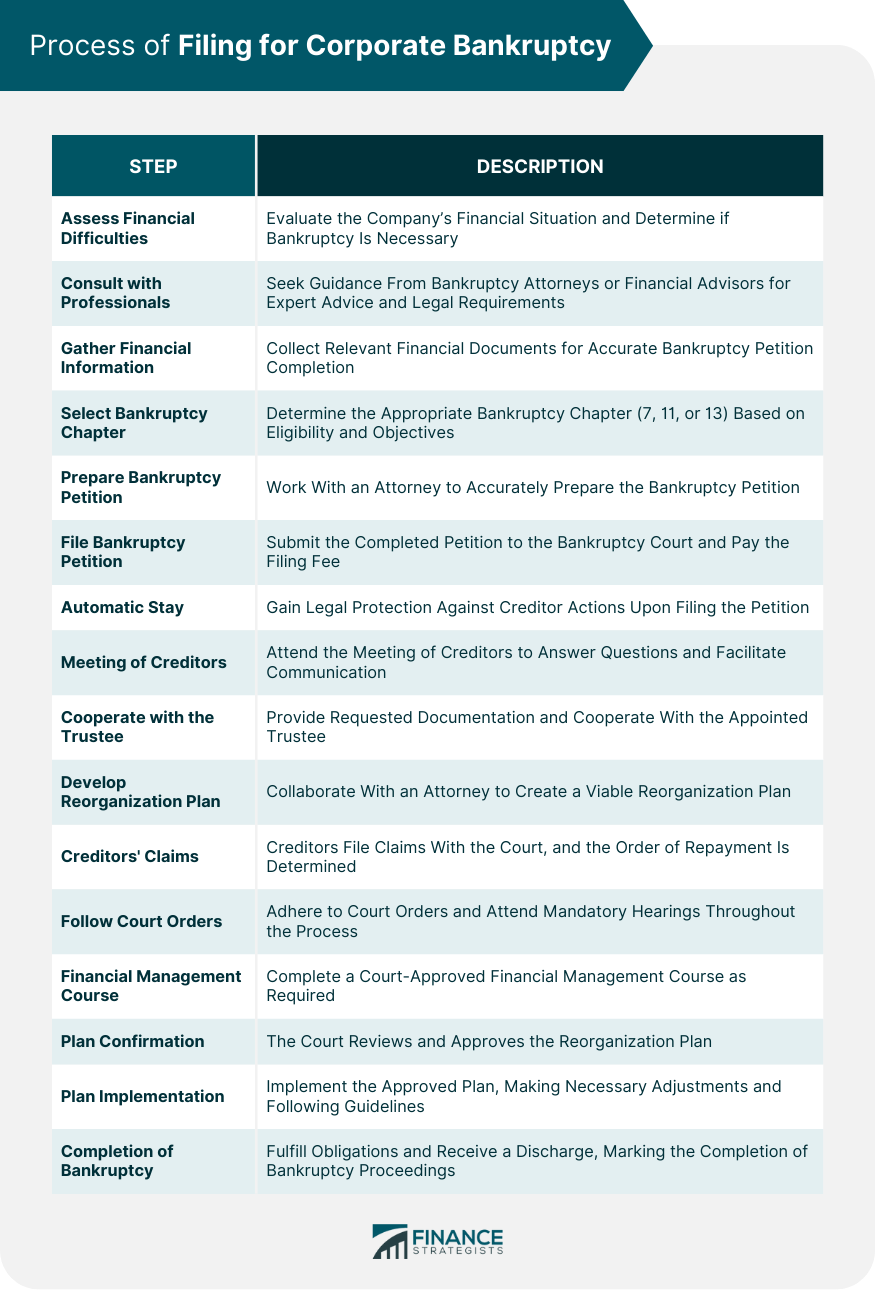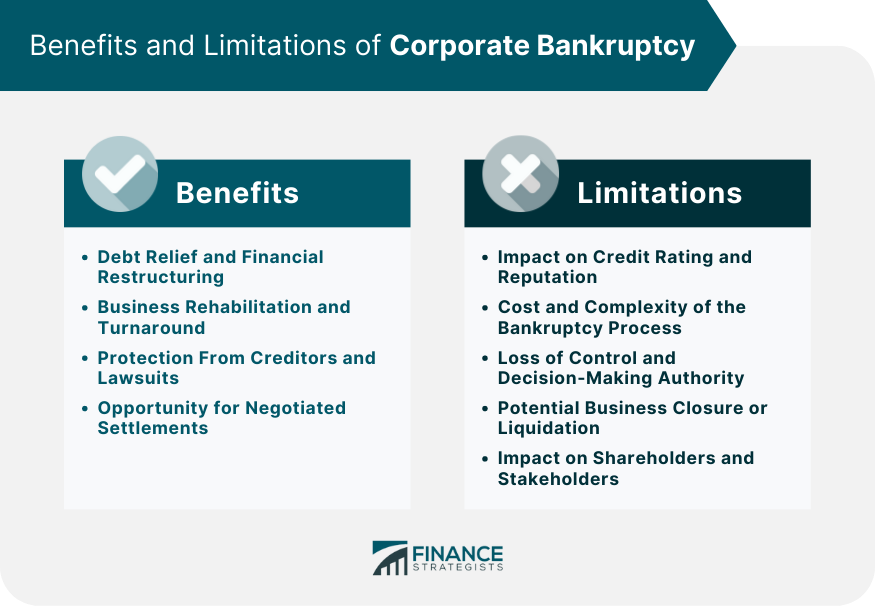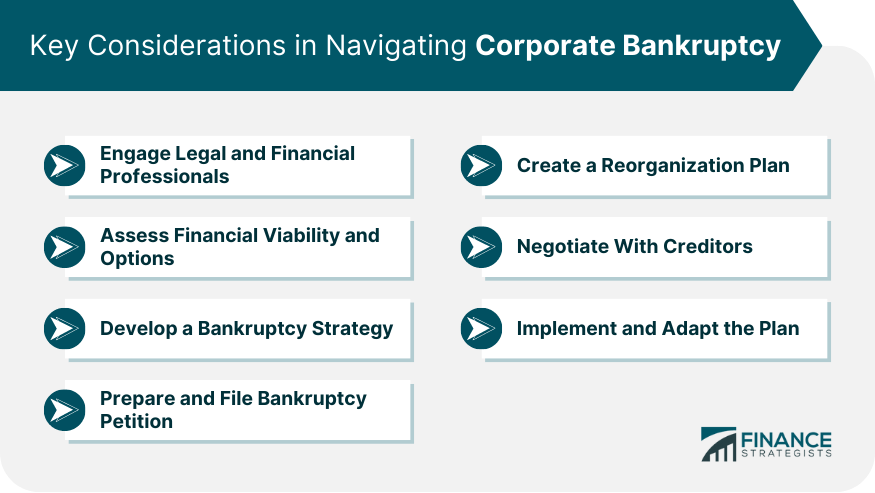Corporate bankruptcy is a situation where a company is unable to meet its financial obligations and seeks legal protection to address its debts. It involves a regulated process that appoints a trustee or administrator to oversee the resolution of financial issues. Bankruptcy provides a structured framework for debt repayment, asset liquidation, or business reorganization, depending on the type of bankruptcy filed. The primary purpose of corporate bankruptcy is to provide a fair resolution for both debtors and creditors. It allows struggling companies to reorganize their finances, negotiate with creditors, and potentially continue operations. For creditors, bankruptcy ensures a systematic and equitable distribution of assets, providing them an opportunity to recover at least a portion of their outstanding debts. Moreover, bankruptcy laws play a vital role in maintaining economic stability and promoting business confidence. Corporate bankruptcy can take different forms depending on the circumstances and the desired outcome. The most common types are Chapter 7, Chapter 11, and Chapter 13 bankruptcy. In this type, a court-appointed trustee liquidates the company's assets to repay creditors. It is typically suitable for businesses with no viable prospects for rehabilitation or reorganization. Chapter 11 bankruptcy focuses on reorganizing a business entity. The company continues operations while formulating a plan to repay debts, renegotiate contracts, and reposition itself for financial viability. Primarily used by individuals or sole proprietors, Chapter 13 bankruptcy allows the debtor to create a repayment plan to settle debts over a specified period, usually three to five years. In some cases, small businesses can also use Chapter 13 bankruptcy. The first step is to assess the company's financial difficulties and determine if bankruptcy is the appropriate course of action. Evaluate the extent of the debt, cash flow problems, and inability to meet financial obligations. Seek guidance from experienced bankruptcy attorneys or financial advisors. They can provide expert advice on the bankruptcy process, assess the viability of alternative solutions, and guide you through the legal requirements. Collect all relevant financial documents, including balance sheets, income statements, tax returns, loan agreements, and contracts. This information will be necessary to complete the bankruptcy petition accurately. Determine the appropriate bankruptcy chapter for your situation. Chapter 7, Chapter 11, or Chapter 13 bankruptcy each has specific eligibility criteria and objectives. Consult with your attorney to determine the best option. Work with your attorney to prepare the bankruptcy petition, which includes detailed information about the company's financial status, assets, liabilities, income, and expenses. Ensure all information is accurate, complete, and disclosed in accordance with legal requirements. Submit the completed bankruptcy petition to the appropriate bankruptcy court. Pay the required filing fee, unless a fee waiver is approved. The court assigns a case number and officially begins the bankruptcy proceedings. Once the bankruptcy petition is filed, the automatic stay goes into effect. This legal protection prevents creditors from pursuing collection actions, such as lawsuits, wage garnishments, or foreclosures. It provides immediate relief and allows the company to focus on resolving its financial situation. The court schedules a meeting of creditors, also known as a 341 meeting. Attend this meeting, along with your attorney, trustee, and creditors. Answer any questions related to your financial situation and provide any additional requested information. The meeting facilitates communication and transparency among all parties involved. Work closely with the court-appointed trustee or administrator. Provide all requested documentation and cooperate fully with their requests. The trustee will review your financial records, assess the company's assets, and oversee the administration of the bankruptcy case. If filing for Chapter 11 bankruptcy, work with your attorney to develop a reorganization plan. This plan outlines how the company will address its financial difficulties, restructure debts, and propose a strategy for long-term viability. The plan must be feasible, approved by the court, and in the best interests of creditors. Creditors must file their claims with the court, providing details of the debts owed to them. The court reviews these claims and determines the order of priority for repayment. Adhere to all court orders and attend required hearings throughout the bankruptcy process. Failure to comply may result in dismissal of the case or other penalties. Complete a court-approved financial management course as required by bankruptcy regulations. This course aims to provide guidance on financial management practices to help prevent future financial difficulties. In Chapter 11 bankruptcy, the court holds a hearing to review and approve the reorganization plan. Creditors have the opportunity to vote on the plan, and the court assesses its feasibility and fairness to all parties involved. Once the reorganization plan is confirmed, implement the plan as approved by the court. Make necessary changes to operations, restructure debts, and follow the guidelines outlined in the plan. After successfully fulfilling the obligations outlined in the bankruptcy plan, the court issues a discharge, releasing the company from most of its debts. The bankruptcy proceedings are completed, and the company can move forward with a fresh financial start. One of the primary benefits of corporate bankruptcy is the opportunity for debt relief and financial restructuring. Bankruptcy allows businesses to discharge or restructure their debts, providing a fresh start and an opportunity to regain financial stability. Debt relief can alleviate the burden of excessive liabilities, enabling the company to reallocate resources and focus on long-term growth. Bankruptcy can serve as a catalyst for business rehabilitation and turnaround. Through the reorganization process, companies can assess their operations, identify inefficiencies, and implement necessary changes to enhance profitability. Bankruptcy often provides the impetus for a thorough examination of the business's structure, operations, and strategies, leading to increased efficiency and competitiveness. When a company files for bankruptcy, it triggers an automatic stay that provides temporary protection from creditors' collection actions and lawsuits. This protection allows the business to regroup, reorganize its finances, and negotiate with creditors under the supervision of the bankruptcy court. The automatic stay can be crucial in preserving the company's assets and preventing further financial deterioration. Bankruptcy provides a structured environment for negotiations between the debtor and its creditors. Through this process, companies can engage in discussions with creditors to reach mutually agreeable settlements. Negotiated settlements can result in debt reduction, extended repayment terms, or other arrangements that facilitate the company's financial recovery. While corporate bankruptcy offers potential benefits, it is essential to consider the challenges and limitations associated with this process. Being aware of these factors can help companies prepare and navigate the complexities involved in bankruptcy proceedings. Filing for corporate bankruptcy can have a significant impact on the company's credit rating and reputation. Bankruptcy filings become part of public records, and credit reporting agencies note them on the company's credit profile. This negative information can make it challenging to obtain credit in the future and may lead to a loss of trust among suppliers, partners, and customers. Corporate bankruptcy can be a costly endeavor. Legal and administrative fees, including attorney fees, court filing fees, and other associated costs, can accumulate quickly throughout the process. The complexity of bankruptcy proceedings also necessitates hiring skilled professionals, further adding to the financial burden. When a company files for bankruptcy, control and decision-making authority often shift to the bankruptcy court and the appointed trustee or administrator. Management may face limitations on day-to-day operations, requiring court approval for significant business decisions. This loss of control can be challenging for executives accustomed to running the company autonomously. While bankruptcy provides opportunities for business rehabilitation, reorganization, or debt restructuring, it is important to recognize that not all companies emerge successfully from the process. In some cases, despite best efforts, businesses may face liquidation or closure due to insurmountable financial challenges or lack of viable alternatives. Corporate bankruptcy can have a significant impact on shareholders and stakeholders. In many cases, shareholders face the risk of losing their investments entirely or receiving minimal returns in the event of liquidation. Employees may experience job losses or significant changes in working conditions. Suppliers, vendors, and other business partners may face financial losses or disruption in their relationships with the company. While bankruptcy may be a suitable option for some businesses, it is not the only solution for financial distress. Several alternatives to bankruptcy exist, each with its own advantages and considerations. Out-of-court workouts involve negotiating with creditors to modify debt repayment terms outside the formal bankruptcy process. This approach allows companies to restructure their debts and potentially avoid the associated costs and public scrutiny of bankruptcy. Out-of-court workouts can be effective when there is goodwill among stakeholders and a willingness to collaborate. Negotiated settlements and payment plans involve discussions between the debtor and its creditors to establish revised repayment terms. This approach aims to facilitate the repayment of debts in a manner that is manageable for the business while satisfying the creditors' requirements. Negotiated settlements can be flexible and tailored to the specific financial circumstances of the company. In certain situations, selling assets or divesting non-core business segments can provide a means to generate cash and reduce financial strain. Asset sales can be conducted outside of bankruptcy, allowing businesses to raise funds and address immediate financial concerns. However, careful consideration must be given to the impact of asset sales on long-term viability and future growth potential. For financially distressed companies, mergers and acquisitions (M&A) can offer opportunities for strategic partnerships or absorption into a healthier business entity. M&A transactions can help troubled companies access capital, operational expertise, and new markets, potentially revitalizing their operations. However, M&A transactions must be carefully evaluated to ensure alignment with the company's long-term objectives and stakeholder interests. Refinancing and debt consolidation involve obtaining new loans or credit facilities to replace existing debts. By refinancing at more favorable terms, companies can lower their interest expenses and improve their cash flow position. Debt consolidation, on the other hand, involves combining multiple debts into a single loan, simplifying repayment and potentially reducing interest costs. Navigating corporate bankruptcy requires careful planning, strategic decision-making, and collaboration with professionals experienced in bankruptcy law and financial restructuring. Companies facing financial distress should consider the following key considerations to optimize their chances of a successful resolution. Bankruptcy law is intricate, and the processes involved can be challenging to navigate without expert guidance. Engaging experienced legal and financial professionals, such as bankruptcy attorneys and financial advisors, is essential to ensure compliance, protect the company's interests, and maximize the benefits of the bankruptcy process. Before proceeding with bankruptcy, it is critical to conduct a comprehensive assessment of the company's financial viability and available options. This assessment should include a thorough evaluation of the business's operations, financial statements, cash flow projections, and market conditions. Understanding the underlying causes of financial distress and the potential for rehabilitation or reorganization is essential for making informed decisions. Based on the assessment of financial viability, companies should develop a bankruptcy strategy tailored to their unique circumstances. This strategy should outline the desired outcome, whether it is debt restructuring, reorganization, or liquidation. A well-defined strategy helps guide decision-making, sets realistic goals, and aligns stakeholders' expectations. Preparing and filing a bankruptcy petition involves assembling the necessary documentation and submitting the required forms to the appropriate bankruptcy court. Accuracy and completeness are crucial during this stage to avoid potential delays or complications in the process. Seeking the assistance of legal professionals ensures compliance and helps streamline the filing process. In Chapter 11 bankruptcy, developing a reorganization plan is a critical step. This plan outlines the company's proposed actions to address financial challenges, repay creditors, and achieve long-term viability. The reorganization plan should be comprehensive, realistic, and supported by thorough financial projections and analysis. It requires collaboration with legal and financial advisors to ensure feasibility and compliance with bankruptcy regulations. Negotiating with creditors is a crucial aspect of the bankruptcy process. Engaging in open and transparent discussions with creditors can lead to mutually beneficial agreements and facilitate the resolution of outstanding debts. Skilled negotiators can help businesses achieve favorable outcomes, such as reduced debt obligations, extended repayment terms, or modified interest rates. Once a reorganization plan is approved by the bankruptcy court, the company must implement and adapt the plan to changing circumstances. This involves closely monitoring financial performance, operational efficiency, and compliance with the plan's provisions. Flexibility and agility are essential during this phase to address unforeseen challenges and ensure successful implementation. Corporate bankruptcy occurs when a company is unable to meet its financial obligations and seeks legal protection to address its debts. It involves a regulated process where a trustee or administrator oversees the resolution of financial issues. There are different types of corporate bankruptcy, including Chapter 7, Chapter 11, and Chapter 13 bankruptcy. Chapter 7 involves liquidating the company's assets to repay creditors, while Chapter 11 focuses on reorganizing the business. Chapter 13 is primarily used by individuals or sole proprietors to create a repayment plan over a specified period. The process of filing for bankruptcy includes assessing financial difficulties, consulting with professionals, gathering financial information, selecting the appropriate bankruptcy chapter, and preparing and filing the bankruptcy petition. Corporate bankruptcy offers benefits such as debt relief, financial restructuring, business rehabilitation, protection from creditors and lawsuits, and opportunities for negotiated settlements. However, it also has limitations, including the impact on credit rating and reputation, the cost and complexity of the process, loss of control and decision-making authority, and the potential for business closure or liquidation. Alternatives to corporate bankruptcy include out-of-court workouts, negotiated settlements and payment plans, asset sales and divestitures, mergers and acquisitions, and refinancing and debt consolidation.What Is Corporate Bankruptcy?
Types of Corporate Bankruptcy
Chapter 7 Bankruptcy
Chapter 11 Bankruptcy
Chapter 13 Bankruptcy

Process of Filing for Corporate Bankruptcy
Assess Financial Difficulties
Consult With Professionals
Gather Financial Information
Select the Appropriate Bankruptcy Chapter
Prepare the Bankruptcy Petition
File the Bankruptcy Petition
Automatic Stay
Meeting of Creditors
Cooperate With the Trustee
Develop a Reorganization Plan
Creditors' Claims
Follow Court Orders and Attend Hearings
Financial Management Course
Plan Confirmation
Plan Implementation
Completion of Bankruptcy Proceedings

Benefits and Advantages of Corporate Bankruptcy
Debt Relief and Financial Restructuring
Business Rehabilitation and Turnaround
Protection From Creditors and Lawsuits
Opportunity for Negotiated Settlements
Challenges and Limitations of Corporate Bankruptcy
Impact on Credit Rating and Reputation
Cost and Complexity of the Bankruptcy Process
Loss of Control and Decision-Making Authority
Potential Business Closure or Liquidation
Impact on Shareholders and Stakeholders

Alternatives to Corporate Bankruptcy
Out-Of-Court Workouts and Debt Restructuring
Negotiated Settlements and Payment Plans
Asset Sales and Divestitures
Mergers and Acquisitions
Refinancing and Debt Consolidation
Key Considerations in Navigating Corporate Bankruptcy
Engage Legal and Financial Professionals
Assess Financial Viability and Options
Develop a Bankruptcy Strategy
Prepare and File Bankruptcy Petition
Create a Reorganization Plan
Negotiate With Creditors
Implement and Adapt the Plan

Conclusion
Corporate Bankruptcy FAQs
Corporate bankruptcy is a legal process where a company unable to meet financial obligations seeks protection and resolves debts under the supervision of a court-appointed trustee or administrator.
The main types of corporate bankruptcy are Chapter 7, Chapter 11, and Chapter 13. Each type serves different purposes, such as liquidation, reorganization, or debt repayment plans.
Corporate bankruptcy offers debt relief, financial restructuring, protection from creditors and lawsuits, and opportunities for negotiated settlements to help struggling companies regain financial stability.
Yes, alternatives to corporate bankruptcy include out-of-court workouts, negotiated settlements, asset sales, mergers and acquisitions, and refinancing/debt consolidation, depending on the specific circumstances.
To navigate corporate bankruptcy successfully, engage legal and financial professionals, assess financial viability, develop a bankruptcy strategy, accurately file the bankruptcy petition, negotiate with creditors, and implement a well-defined reorganization plan if applicable.
True Tamplin is a published author, public speaker, CEO of UpDigital, and founder of Finance Strategists.
True is a Certified Educator in Personal Finance (CEPF®), author of The Handy Financial Ratios Guide, a member of the Society for Advancing Business Editing and Writing, contributes to his financial education site, Finance Strategists, and has spoken to various financial communities such as the CFA Institute, as well as university students like his Alma mater, Biola University, where he received a bachelor of science in business and data analytics.
To learn more about True, visit his personal website or view his author profiles on Amazon, Nasdaq and Forbes.















